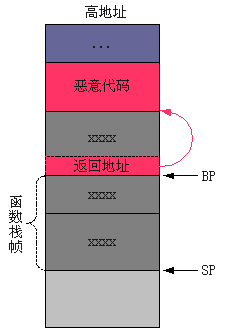

It will then place it on the stack just after the stored, previously constructed stack frame. It will obtain the canary’s value from ‘%gs:0x14’ and store it in EAX register.
Gcc stack smashing detected code#
This is the actual stack canary code in the binary.

Next, the current value of ECX (containing the original stack pointer’s value) is also pushed on the stack and stack pointer is decremented by 0x14 in order to make sufficient space for the function. The current base pointer (indicating a new stack frame) is pushed onto the stack and value of the stack pointer is placed in the base pointer. Then, the well known function prologue takes place. The address of the stack pointer at an offset of 0x4 is loaded to ECX, then stack pointer is aligned and the original stack pointer (ECX-4) is pushed into the stack. Since this post is mostly written for people that are just getting started with system’s internals, I’ll explain everything.

Xorl:~$ gcc -fstack-protector-all ahoy.c -o ahoy -ggdb2 We’ll compile it using the -fstack-protector-all to force GCC into using the Stack Smashing Protection features it has. Just the GLIBC’s stack canary value’s functionality. WARNING: There is no exploitation information in this post. So, here is my writing on how GNU C Library stack canary values work. After performing a quick online research I wasn’t able to find anything useful to give him. To disable ASLR, on linux it is disabled by setting randomize_va_space to 0.I was recently been asked by a friend how the Linux’s stack canary values work. To get the consistent behaviour every time, you need to disable ASLR as well. Sometimes the overflown buffer does not reaches to canary and sometimes it does. It means the address space allocation is random and the bytes between your vectors is different every time. In order to prevent an attacker from reliably jumping to, for example, a particular exploited function in memory, ASLR randomly arranges the address space positions of key data areas of a process, including the base of the executable and the positions of the stack, heap and libraries. When you compile your program your compiler gcc/g++ optimize your executable for security mechanisms to prevent buffer overflow exploits.Īddress space layout randomization (ASLR) is a computer security technique involved in preventing exploitation of memory corruption vulnerabilities. Your program behaviour is random because probably you have not disabled ASLR (Address space layout randomization). You need to configure your compiler to make it easier for buffer overflow. The fact this error is not consistent because sometimes the canary does not get overwritten (fine run of program) or overwritten by the same exact value and sometimes the canary gets overwritten with a different value leading to this error. To see if a data from vector 1 appears in vector 2 this indeed seems like buffer overflow kind of assignment where you are required to overwrite contents of arrays from one another. If it is a computer security assignment where you are working on a buffer overflow exploit then you need to figure out to bybass these security mechanism, if you are not familiar with it, then somehow you are overflowing buffer and without looking at code I can't comment much where exactly the problem is. However, disabling stack-protection will remove this error but you might get segmentation fault as a result of overwriting stack. To avoid this error, disable fstack-protector in gcc while compiling the code using g++ myProgram.c -o myProgram -fno-stack-protector This is a security mechanism implemented by gcc/g++ to prevent buffer overflow exploits using -fstack-protector. *** stack smashing detected *** error occurs when as the name suggests, you smash the stack, meaning that you have a buffer overflow and the canary gets overwritten by a different value.


 0 kommentar(er)
0 kommentar(er)
